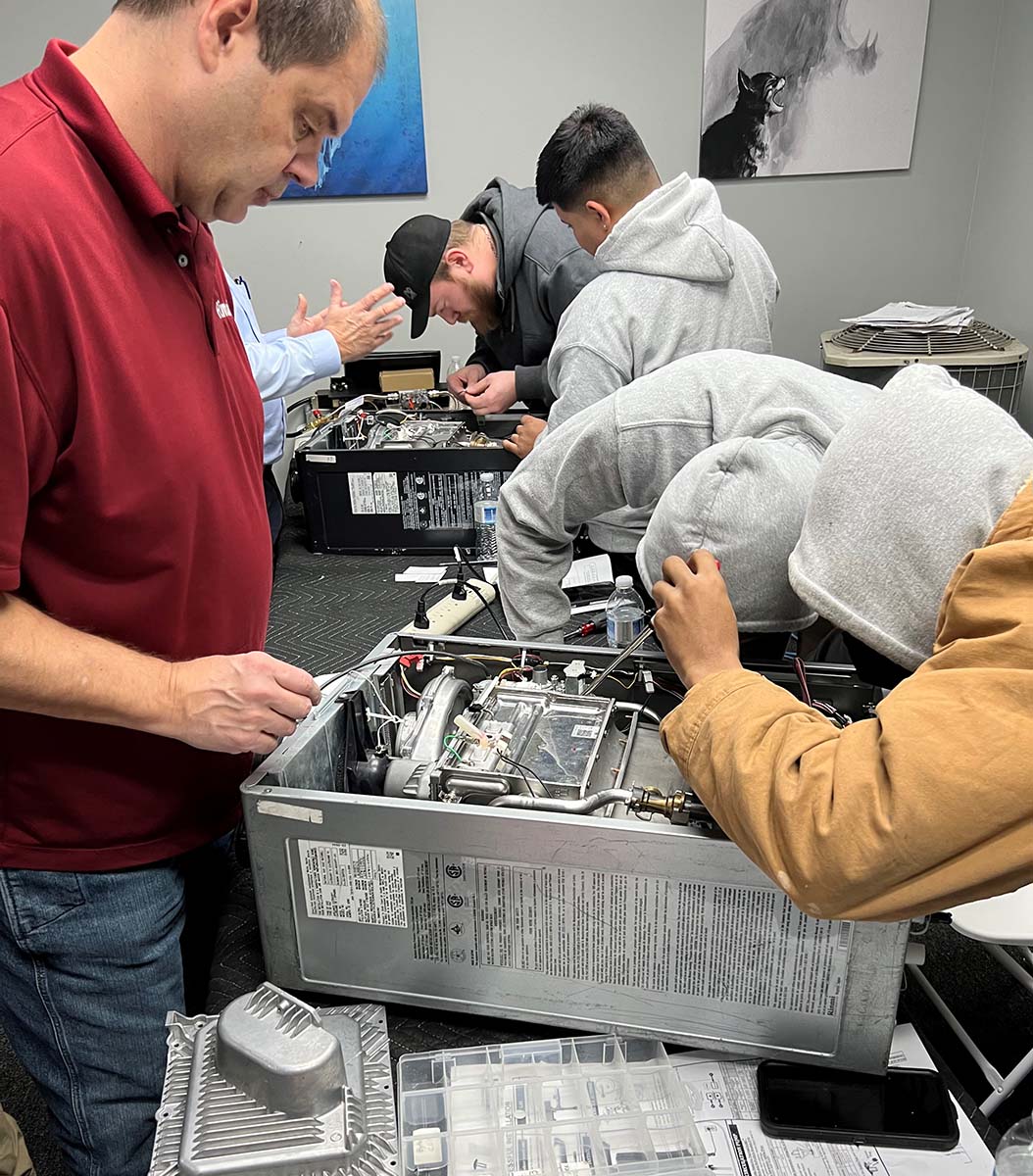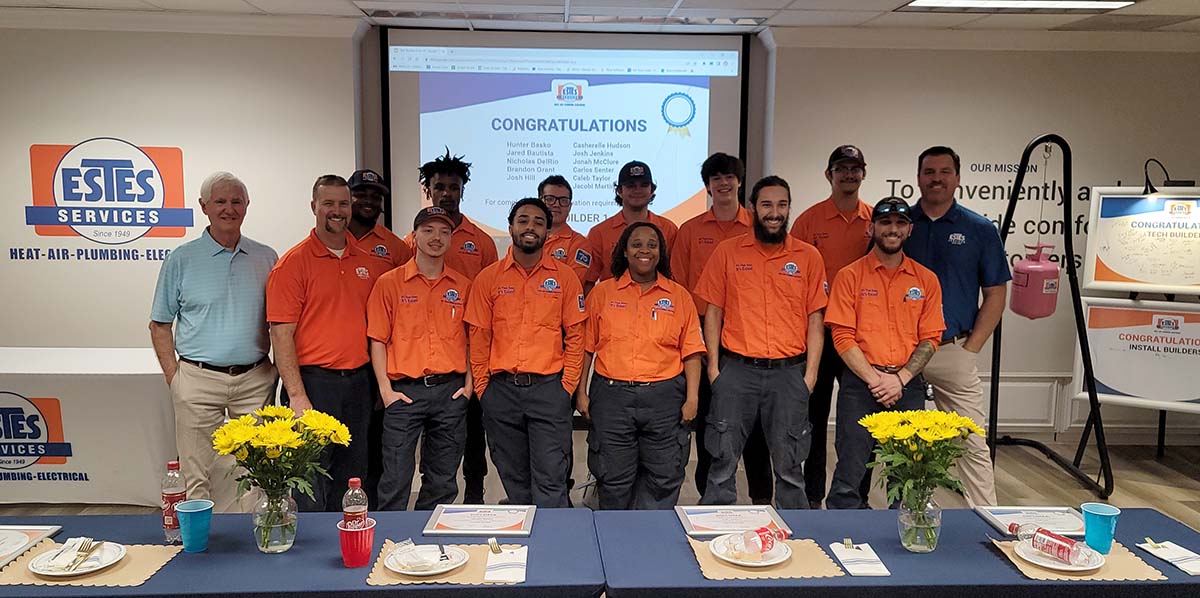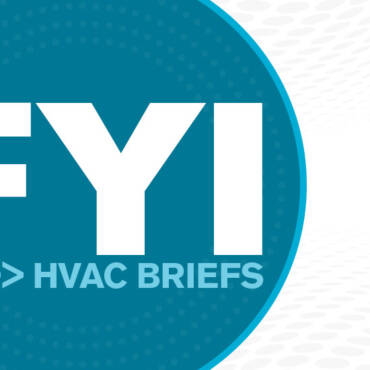✕
With no real end in sight to the labor shortage, some contractors have taken it upon themselves to create the talent they need by opening an HVACR trade academy, university, facility, etc. But it takes a lot of work to make it happen.
Contractors have to have set goals and visions in place, thoughtfully decide on a curriculuam that is tailored to what type of students they are trying to bring in, find or design a space that can house students and faculty plus all the needed equipment to train, secure the necessary finances, hire a credible lead instructor, and market it, to name a few.
And, when it’s done right, contractors have a direct hand in cultivating the future of the HVACR industry, ensuring that technicians are trained the right way so customers are well-served for years to come.
Steps to Take
The first step a contractor should take if they are considering opening up their own training outfit is outlining their goals and visions.
“First, have the vision,” said Josh Buhler, owner of Oakland Heating and Air LLC in Indianapolis and president of Hoosier Trade School. “Next, have faith that the vision you have will come true.”
Brynn Cooksey, owner and general manager of Air Doctors Heating and Cooling in Belleville, Michigan, and also the founder of HVAC U, a technical trade school and training organization, recommends that contractors leverage existing resources for their new academy. Things like older pieces of equipment or parts could be reused for training. Additionally, contractors should be specific about the scope, length, and content of the program.
Of course, any good training academy needs a lead instructor who knows their stuff.
“Have a lead instructor who is at senior knowledge level of the trade, and have that person be exceptionally good at communication and developing professional relationships with individuals,” Buhler said.
When HVAC U first started, they used their senior technician to train the newer technicians.
“We recommend some type of industry credential to verify professional and competency,” Cooksey said. “Industry certifications also build creditably.”
Hoosier Trade School has NATE certifications, Environmental Protection Agency (EPA) Universal certifications, and an Indianapolis HVAC contractor license on file.
“EPA is required by law to handle refrigerant, NATE is a great feather in the cap in the HVAC industry, and anyone who has looked into the Indianapolis HVAC contractor’s testing requirements knows that that is an extremely hard license to obtain,” Buhler said.
Contractors will also have to successfully market the trade school to get students in the door. Fortunately, it’s much like the current marketing contractors are already doing for their HVAC companies — things like creating a website, utilizing social media, engaging with the local community, purchasing Google ads, and leveraging partnerships.
“Many contractors are a part of some type of trade organization or best practices group,” Cooksey said. “Members of the group often experience the same issues they may have. This would be a great place to start marketing. Local distributors are also a great way to spread the word.”
Hoosier Trade School first began to get traction from its website and spent some money on Google ads.
“Also, we had a great response on the phones from a billboard effort targeted at half a million views,” Buhler said.
Buhler said they’ve also visited high schools. Hoosier Trade School also gets a great response on their Instagram, where they share pictures and videos from class.
Considerations
When it comes to designing this training academy, one of the biggest things contractors for contractors to consider is the financial investment it’ll take.
“Financially, this is a tough game to get started,” Buhler said. “Funding and student grant money from the state and federal level, as well as the military, won’t be available until 2+ years of good track record for the school. To open those doors, you must first prove you are graduating students and landing them in their trade with increased value and pay.”
Buhler said it’s also a good idea to have one year’s rent/mortgage put aside and one year’s teacher salary ready to go, not to mention the money it’ll cost to purchase equipment and training tools.
As far as the most important features for this academy to have, Buhler said for Hoosier Trade School, it’s been great having a large open space where they can both teach and do hands-on training. Equipment tables that are conducive to easy access and operation of the equipment have also proven beneficial. To operate many systems at once, the building will need a strong gas and power supply.
Cooksey said contractors should get creative when considering a training program or facility.
“We started by using older equipment that we brought back to the office after a system replacement,” Cooksey said. “The equipment was installed in our office, and we were able to set up various lab stations by using equipment that was destined for the scrap yard.”
Many of Cooksey’s suppliers were very supportive and offered up used equipment for free or at a considerable discount.
“The most important feature for us was to have equipment in our training facility that reflected the area we served,” Cooksey said.
As far as the space and size of the facility, it really depends on what that contractor’s goals are.
“Will this be an in-house training program, or are you going to use it as a for-profit business unit? We designated a portion of our shop area for our training courses,” Cooksey said. “As the demand grew from other contractors in the area, we made plans to expand our training facility.”
As for Hoosier Trade School it’s 6,000 square feet, and efficiently houses 12 students, an office admin, the instructor, the tables and chairs needed for learning and training, and 20+ HVAC systems.
“Also, it’s a great idea to have a parking lot big enough to park 15+ cars and still have room somewhere for outdoor storage,” Buhler said.
Curriculum
The curriculum is obviously the most important factor of the training facility. Contractors will have to decide how much of a role hands-on training will play, what to cover, and then ensure that it remains current and effective.

HANDS-ON: The most successful training programs will have the right combination of hands-on training and discussion/study. (Courtesy of HVAC U)
“Hands-on training is our main focus — it’s what the school is built on,” Buhler said. “The curriculum should be dictated by your target student body. In our case, we have started with entry-level individuals off the street who have no tools or prior HVACR training.”
Hoosier Trade School’s curriculum is designed to help prepare those types of students to hit the ground running once they enter the HVAC field. It’s Buhler’s personal belief that the best way to train at this level is 75% hands-on and 25% discussion/study.
There are also several organizations that have curriculums already available for general use.
“Companies like RSES (Refrigeration Service Engineers Society) and ESCO Institute have materials for purchase that can be used to get your training program off of the ground,” Cooksey said. “Most of the training materials have PowerPoints and lecturer notes that can be purchased to help the trainer craft an effective training course.”
To ensure their curriculum stays current with the ever-evolving HVACR industry, Hoosier Trade School has also consulted a prominent equipment supplier in town to bring in additional training for the new technology entering the HVAC field the next calendar year. Specifically, they are bringing in a professional instructor from a top HVAC brand to teach a four-hour class about the refrigerant change.
“Our future plan to ensure we stay up to date with the HVAC market includes tapping into community resources like mentioned above to offer the very best training and exposure as our field continues to evolve,” Buhler said. “Also, we have a great HVAC company that shares some space in the back shop — so we have direct access to up-to-date information from the field every day. As new equipment and tools come out, we are sure to be some of the first to know about it.”
HVAC U
The inception of HVAC U was the worker shortage. Air Doctors Heating and Cooling needed people. Plus, Cooksey recognized how expensive traditional college and trade schools can be, not to mention how restrictive regarding their schedule.
“We started our training program to fast-track technician training without the large expense,” Cooksey said. “The training was initially designed for employees of our business, but then others voiced similar needs, so we opened it up so that other companies can benefit from the training.”
The average age of their technician is 23 years old. While originally designed for a way to reduce technician callback and rework, they quickly discovered it was a great way to get younger technicians up to speed quickly, to support the demand for workers.
“Now it is a legitimate business unit and a profit center,” Cooksey said.
Hoosier Trade School
It was a no-brainer for Buhler to open up Hoosier Trade School. He was inspired by his own love and passion for the trades.
“When I finally was exposed to the trades in a commercial setting, I fell in love with them,” Buhler said. “It was great in my mid-20s to be on job sites where all trades were dressed professionally, and from what I saw, for the most part, the men and women working on the job sites took pride in their work.”
Hoosier Trade School takes a hands-on approach to learning the trades and encourages students to take pride in their work, dress professionally, and do honest work for the community.
In terms of what he hopes to achieve through the school, Buhler’s plan is to inspire and motivate the next generation of individuals entering the trades to better their lives and the community.
Estes Services
When Estes Services in Atlanta and Kennesaw, Georgia, opened the Estes HVAC Tech Builder Program in 2014, the inaugural class had just four graduates. Today, more than 23 classes have been conducted, and 86% of their technicians have also participated in the program.

ESTES: Students from the Estes HVAC Tech Builder Program. (Courtesy of Estes Services
“The Estes HVAC Tech Builder Program has been a remarkable success in developing the next generation of skilled technicians at Estes Services,” said John Waldorf, vice president at Estes Services. “Since its inception, we’ve focused on empowering our team with the knowledge and hands-on training to deliver superior service. … This initiative, designed to enhance both technical and customer service skills, has not only strengthened our workforce but also allowed Estes Services to meet the evolving needs of our customers continuously.”
Estes Services, under the leadership of marketing manager Catalina Alzate and in collaboration with their marketing partner Alpyne Strategy, has successfully positioned the Estes HVAC Tech Builder Program at the top of search engine rankings.
Whether you require installation, repair, or maintenance, our technicians will assist you with top-quality service at any time of the day or night. Take comfort in knowing your indoor air quality is the best it can be with MOE heating & cooling services Ontario's solution for heating, air conditioning, and ventilation that’s cooler than the rest.
Contact us to schedule a visit. Our qualified team of technicians, are always ready to help you and guide you for heating and cooling issues. Weather you want to replace an old furnace or install a brand new air conditioner, we are here to help you. Our main office is at Kitchener but we can service most of Ontario's cities
Source link


